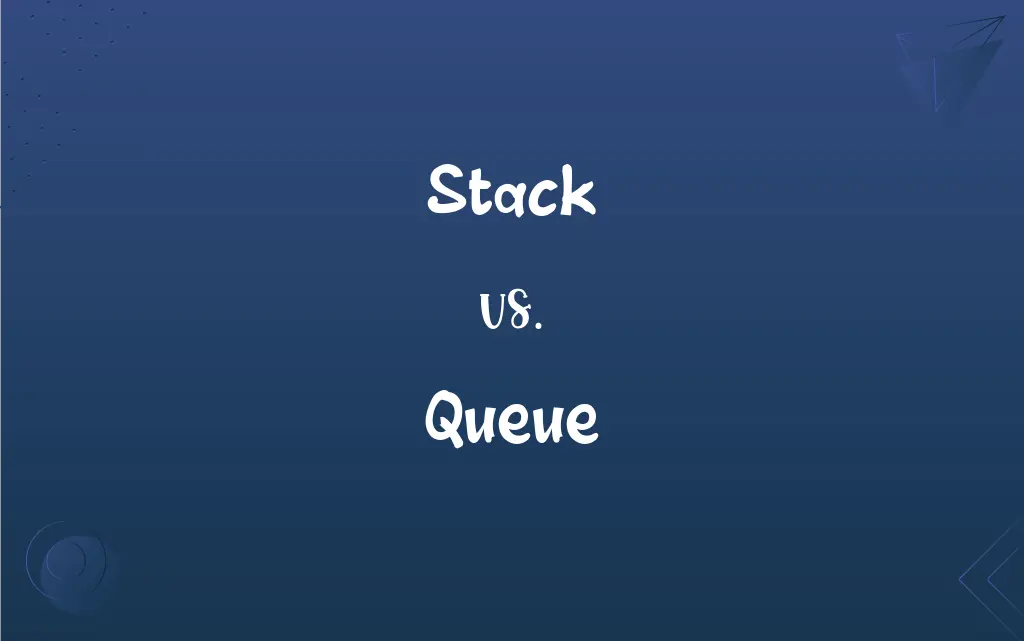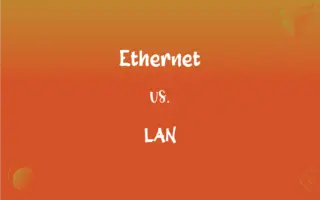Stack vs. Queue: What's the Difference?
Edited by Aimie Carlson || By Harlon Moss || Published on February 22, 2024
A stack operates on a Last In, First Out (LIFO) principle, while a queue uses a First In, First Out (FIFO) method.

Key Differences
A stack is a data structure that stores elements in a LIFO manner, meaning the last element added is the first to be removed. In contrast, a queue operates on a FIFO principle, where the first element added is the first to be removed.
In a stack, both the operations of adding (push) and removing (pop) elements occur at the same end, often referred to as the top of the stack. In a queue, however, elements are added at one end (rear) and removed from the other end (front).
Stacks are akin to a pile of plates; as you add more plates, the most recently added is always on top and is the first to be taken off. Queues resemble a line of people; the person at the front of the line is served first, and new people join at the back of the line.
The stack is often used in scenarios like undo mechanisms in software or for managing function calls in programming. A queue is used in scenarios such as print job management in a printer or handling requests in server processing.
A real-world analogy for a stack is a stack of books on a table, where you only access the top book. For a queue, consider a grocery store checkout line, where the first person in line is the first to be served.
ADVERTISEMENT
Comparison Chart
Order of Operation
Last In, First Out (LIFO)
First In, First Out (FIFO)
End of Operation
Single end (top) for both push and pop
Different ends (rear for enqueue, front for dequeue)
Real-world Example
Stack of plates
Line at a movie ticket counter
Usage in Programming
Function calls, undo mechanisms
Print job management, server request handling
Access Point
Only the top element is accessible
Both ends are accessible but for different operations
ADVERTISEMENT
Stack and Queue Definitions
Stack
A large, tall chimney or column of smoke or steam.
The factory's stack bellowed smoke into the sky.
Queue
A line of people or vehicles waiting their turn.
There was a long queue at the movie theater.
Stack
A number of aircraft flying in circles at different altitudes waiting to land.
The control tower instructed the plane to enter the stack.
Queue
A data structure that allows adding and removing elements in a FIFO manner.
The printer processes print jobs using a queue.
Stack
A data structure that allows adding and removing elements in a LIFO manner.
The program uses a stack to manage function calls.
Queue
To arrange or line up in a sequence.
The passengers queued up for boarding.
Stack
A pile of objects arranged one above another.
He made a neat stack of books on his desk.
Queue
A list or sequence of items, especially in a process waiting to be handled.
My download queue is full of movies.
Stack
A large amount of something, typically neatly arranged.
She had a stack of reports to complete.
Queue
A braid of hair worn at the back.
She styled her hair in a traditional queue.
Stack
An orderly pile, especially one arranged in layers
A stack of newspapers.
Queue
A line of waiting people or vehicles.
FAQs
How do you add an item to a stack?
You add an item to a stack using the push operation.
What is a common use of stacks in computing?
Stacks are commonly used for managing function calls in programming.
What is the main principle of a stack?
A stack operates on a Last In, First Out (LIFO) principle.
How are elements accessed in a stack?
In a stack, elements are accessed only from the top.
Can you access the bottom element of a stack directly?
No, you cannot directly access the bottom element in a stack.
Can you add items to the front of a queue?
No, items are added to the rear of a queue.
Are queues efficient for real-time data processing?
Yes, queues are often used in real-time data processing.
What is a common use of queues in computing?
Queues are commonly used for managing tasks like print job scheduling.
How do you remove an item from a queue?
You remove an item from a queue using the dequeue operation.
What is the main principle of a queue?
A queue operates on a First In, First Out (FIFO) principle.
How are elements accessed in a queue?
Elements in a queue are accessed from the front.
Is a stack a linear data structure?
Yes, a stack is considered a linear data structure.
Can stacks be implemented using arrays?
Yes, stacks can be implemented using arrays or linked lists.
Do stacks preserve the order of elements?
Stacks preserve the order in a LIFO manner.
What happens when you dequeue from an empty queue?
Dequeuing from an empty queue generally causes an underflow error.
Is a queue suitable for priority-based tasks?
Generally no, for priority tasks, a priority queue is more suitable.
What happens when you pop an item from an empty stack?
Popping an item from an empty stack typically results in an underflow error.
Do queues preserve the order of elements?
Queues preserve the order in a FIFO manner.
Can you implement a stack using a queue structure?
Yes, but it requires multiple queues to mimic a stack's behavior.
Are queues used in multiprocessing systems?
Yes, queues are used in multiprocessing for task scheduling and management.
About Author
Written by
Harlon MossHarlon is a seasoned quality moderator and accomplished content writer for Difference Wiki. An alumnus of the prestigious University of California, he earned his degree in Computer Science. Leveraging his academic background, Harlon brings a meticulous and informed perspective to his work, ensuring content accuracy and excellence.
Edited by
Aimie CarlsonAimie Carlson, holding a master's degree in English literature, is a fervent English language enthusiast. She lends her writing talents to Difference Wiki, a prominent website that specializes in comparisons, offering readers insightful analyses that both captivate and inform.































































